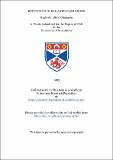Files in this item
Repetition in isolated crab axons
Item metadata
| dc.contributor.advisor | Horridge, G. Adrian | |
| dc.contributor.author | Chapman, R. A. | |
| dc.coverage.spatial | 225 p. | en_US |
| dc.date.accessioned | 2018-07-02T10:48:17Z | |
| dc.date.available | 2018-07-02T10:48:17Z | |
| dc.date.issued | 1963 | |
| dc.identifier.uri | https://hdl.handle.net/10023/14785 | |
| dc.description.abstract | Isolated and identified crab axons have been used to study the forms of the repetitive responses to direct current. Using techniques which enable the responses of isolated axons to be studied at the site of imposed electrical currents, the responses can be classified into five major groups with two subdivisions:- Group 1. Axons showing no marked supernormality during the recovery cycle, that repeat over a wide range of frequencies when stimulated by direct current, with frequency increasing smoothly with the strength of applied current, Group ia. To direct current these axons yield a train of impulses, the intervals between which progressively lengthen. Group ib. To direct current these axons yield a train of impulses the Intervals between which, for some time at least, progressively shorten. Group ll. Axons showing a pronounced supemomality during the recovery cycle, that repeat over only a limited frequency range. Group lla. Axons capable of long latencies, with oscillatory subthreshold potentials before and after the repetitive response. Group llb. Axons showing only short latencies, and lacking subthreshold oscillations before the repetitive response, but nevertheless with oscillations following the response. Group lll. Axons with a prolonged long-lived supemormality during the recovery cycle, which can be correlated with a prolonged action potential. They can repeat over a wide range of frequencies stimulated by direct current, but lack true local potentials for all action potentials except the first. Group lV. Axons with a relatively prolonged subnormality during the recovery cycle. They show short trains of action potentials, the amplitude of which progressively decreases even to near threshold currents, and the interspike intervals show a smooth increase. Group V. Axons unable to repeat to direct current, having a low safety factor and high threshold. They are capable of only short latencies. The single action potential shows a considerable variation in amplitude. A wide varied of experiments have been carried out, which have shown that several factors influence the form of the repetitive response in crab axons, and that the inadequacy of previous theories stems from their oversimplification. The factors show to operate in determining the form of these responses are:- 1. Changes in the resistance of the axon membrane, so that a constant current pulse will not cause the sane potential displacement while it acts. These changes can occur as the result of ionic accumulation outside the axon, or from the active process of delayed rectification. 2. The duration and from of the recovery cycle limits the upper frequency of the repetitive response, as well as influencing it at other times. 3. Sustained depolarisation depresses excitability, by lengthening the repolarisation time of an action potential and the period of recovery following it, as can be seen when the threshold potential for the spike rises throughout a repetitive response. 4. Changes in the membrane potential that result from the accumulation of ions in the near vicinity of the axon membrane. These changes, although they show some interdependence, are often difficult to completely eliminate any particular one by experiment. Although these factors have not been measured quantitatively, on account of technical difficulties inherent in the use of crab axons, they are sufficient to provide a coherent interpretation of repetition. | en_US |
| dc.language.iso | en | en_US |
| dc.publisher | University of St Andrews | |
| dc.subject.lcc | QP363.C5 | |
| dc.subject.lcsh | Axonal transport | en |
| dc.title | Repetition in isolated crab axons | en_US |
| dc.type | Thesis | en_US |
| dc.contributor.sponsor | Nuffield Health | en_US |
| dc.type.qualificationlevel | Doctoral | en_US |
| dc.type.qualificationname | PhD Doctor of Philosophy | en_US |
| dc.publisher.institution | The University of St Andrews | en_US |
This item appears in the following Collection(s)
Items in the St Andrews Research Repository are protected by copyright, with all rights reserved, unless otherwise indicated.

